TECHNICAL SPECIFICATION GUIDEMortice Locks & Latches for Timber DoorsMortice locks and latches are those that are concealed within a pocket (a mortice) formed in the door edge with the lock faceplate and striking plate being fully visible only when the door is in the open position. There are many types of mortice locks and latches available with different types of locking mechanisms and different functions and care should be taken to ensure that the correct type and grade is selected with regard to door furniture being used, security needs and door function. Correctly specified locks and latches will enhance door operation and user experience and, if fitted correctly and properly maintained, will provide many years of trouble free service. To specify the correct lock or latch for any given scenario there are a number of factors that need to be taken into consideration. Whilst the majority of situations are straightforward and present few problems, it is important to recognise where special care is required to ensure trouble free operation. We have produced this guide to assist in the selection of locks and latches and to highlight potential problem areas. FACTORS TO CONSIDER:
DOOR CONSTRUCTION & THICKNESS:Mortice locks and latches are fitted into pockets formed in the door edge and you should ensure that doors are thick enough to accommodate both the thickness of the lock/latch body and the width of the faceplate. Generally, the minimum door thickness requirement for mortice locks/latches is 35mm although some heavy duty types will require doors to be 45mm or over. A lock should have strength at least equal to the door on which it is fitted. Such fitting must not weaken the door in order to accommodate the lock. Where latches or locks incorporating a latchbolt are to be fitted, consideration should to be given to the tongue dimension of the striking plate. On thicker doors it is normal practice to fit the lock/latch offset from the door thickness centre line to ensure that the striking plate tongue is positioned correctly to facilitate smooth operation and avoid damage to the door frame. LATCH & LOCK TYPES:As mentioned in the introduction to this guide, mortice locks and latches are available in different formats and various functions with each designed to perform a particular task. These range from simple locks for securing service cupboard doors, high security locks for external doors and locks that allow free, keyless exit in emergency situations. However, as many of these functions are highly specialist and narrow in their scope, this guide is limited to detailing the most common types only. Mortice Latches: The term "latch" normally refers to a mechanism designed to hold a door closed when not locked. Mortice latches perform this task using a sprung, bevelled latchbolt or sprung rollerbolt which can be retracted by lever door handles or door knobs etc. Whilst this function is common to all mortice latches it is important to stress the need to select latches suitable for the door furniture being used with regard to size, spring strength and action - more on this in the Door Furniture Compatibility section further down. 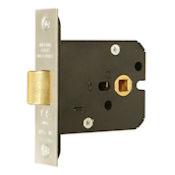 Box Mortice Latch  Tubular Mortice Latch Mortice Deadlocks: The term "Mortice Deadlock" generally refers to locks that incorporate a single unsprung deadbolt that is thrown and withdrawn by key (on 3 lever or 5 lever mechanisms for example) or thumbturn (on cylinder deadlocks fitted with a key/thumbturn cylinder). Deadlocks are normally fitted to doors that either do not require any latching mechanism (such as service cupboard doors or lockable passage doors fitted with door closing devices) or to doors that have a separate latching method (such as house entrance doors fitted with a nightlatch). 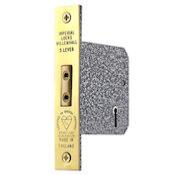 5 Lever Mortice Deadlock 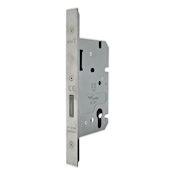 Euro Profile Cylinder Deadlock Mortice Sashlocks: Sashlocks are generally locks that incorporate both a sprung latchbolt (normally operated by door knobs or lever handles) and a deadbolt thrown and withdrawn by key (on 3 lever or 5 lever mechanisms for example) or thumbturn (on cylinder sashlocks fitted with a key/thumbturn cylinder). Sashlocks are normally used when doors require a method of keeping them in the frame when not locked and where no separate latching mechanism is fitted. Sashlocks are also sometimes referred to as "latch locks" or simply "mortice locks". 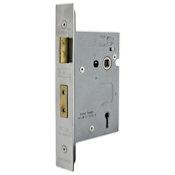 3 Lever Upright Sashlock 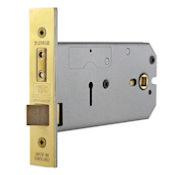 3 Lever Horizontal Lock Mortice Privacy Locks: Privacy locks are generally fitted to bathroom/toilet doors or other doors where simple keyless locking is required and normally incorporate an un-sprung deadbolt that is thrown or retracted by internal thumbturn. Some privacy locks are also fitted with a sprung latchbolt operable by lever handles or door knobs. 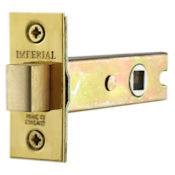 Mortice Privacy Deadbolt 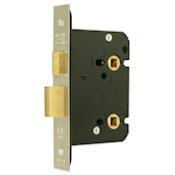 Mortice Privacy Lock LOCKING MECHANISM & SECURITY:The purpose of most locks is to secure buildings, or the areas and rooms within, against unauthorised entry or to provide privacy. While low security or privacy situations require little thought, high security applications should be afforded a little more consideration. Higher security locks offer greater protection against known forms of attack such as forcing, drilling and picking and, in some cases, unauthorised duplication of keys. A good starting point is to remember that a lock should possess security proportional to the value of that being protected. The four main types of locking mechanism and security grades that we offer in our range are detailed below: Privacy Mechanism - Low Security: Privacy locks are designed to provide a simple keyless locking action on bathroom and toilet doors. The locking deadbolt is normally thrown and withdrawn by operation of a thumbturn. In many cases an emergency release is also fitted to allow operation of the lock externally in an emergency. This locking method is available in deadlock, sashlock and horizontal lock formats in both UK and European case sizes.  Mortice Privacy Lock 3 Lever - Medium Security: 3 lever locks offer a medium security solution for internal doors where higher security locks are not required. They are often specified for smaller commercial applications for locking of office doors etc. Operation of the deadbolt is normally by key from either side. 3 lever locks are available in standard UK case sizes in deadlock, sashlock and horizontal lock types. Certain makes can be keyed alike in groups or supplied as part of a master key system.  3 Lever Horizontal Sashlock 5 Detainer & British Standard 5 Lever - High Security: 'CHUBB' Detainer and British Standard 5 lever locks offer a high degree of physical security and are recommended for any external and internal door where a high security lock is required. Operation of the deadbolt is normally by key from either side. Locks certified to BS3621 and bearing the British Standard Kitemark are generally accepted by most insurance companies for use on final exit doors. British Standard mortice locks are generally available in deadlock and upright sashlock format only. Certain makes can be keyed alike in groups.  5 Lever Mortice Deadlock Cylinder Locks - Medium to High Security: Cylinder locks are those that require the addition of a cylinder (or barrel) to operate the locking mechanism. This type of lock is extensively specified for commercial projects due to the different cylinder functions available and the scope for complex master key systems. The locking function may be operated by single cylinder (key one side only), double cylinder (key both sides) or cylinder and turn (external key and internal thumbturn). Cylinders are available in different lengths to suit varying door thicknesses and with different levels of security. High security cylinders have greater protection against known forms of attack and many feature patented keyways where duplicate keys are highly restricted. Where physical security is required, a high security cylinder should be paired with a high security lock case. 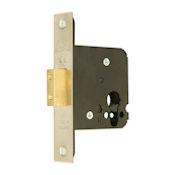 Euro Profile Cylinder Deadlock 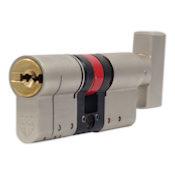 Euro Profile Key & Thumbturn Cylinder DOOR FURNITURE COMPATIBILTY:Selecting the right lock or latch with regard to the door furniture being used is where many people fall foul. Unfortunately, mistakes in this area are seldom rectified due to the costs involved of fitting replacements and making good joinery or, worse still, having to buy new doors. Subsequently, many doors are left with drooping lever handles or door knobs that are unusable. However, following a few basic rules should help overcome the most common mistakes. Door Knob Furniture: Door knobs should ideally be fitted away from the door edge to avoid rapping your knuckles on the frame. Traditional panelled doors, for example, are often fitted with 'horizontal' locks/latches that position the knob along the centre rail. On locks and latches, the measurement from the edge of the door to the centre of the handle follower is called the "backset" and it is this measurement that determines the position of any handle fitted. For smaller door knobs of up to 48mm diameter we recommend locks and latches with a minimum 57mm backset. For larger knob diameters a deeper backset measurement will normally be required.
In addition, knobs fitted to heavier sprung latch mechanisms can be hard to turn, especially for children and the elderly or with wet hands. Latches for use with door knobs therefore require lighter springing than those for lever handle furniture. Ideally, door knobs should be used with locks and latches described as being "light or medium sprung" and "two-way action" as this allows the knobs to be turned with ease in both directions. For best results, select locks and latches that have been designed specifically for use with door knobs as these will feature both the deeper backset measurement and suitable springing as standard. 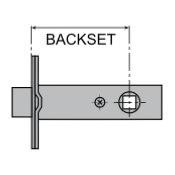 Backset Measurement  Tubular Mortice Latch with Deep Backset Top Tip - With very few exceptions, horizontal locks tend to offer only a medium degree of security. If you require a deep backset AND high security, consider fitting a tubular latch plus a high security deadlock elsewhere on the door. Lever Handle Furniture: When selecting locks and latches for use with Lever Handles care needs to be exercised in two main areas - follower spring strength and the centres measurement.
Lever door handles described as being "sprung" or "self-sprung" are manufactured with integral springing in the handle backplate/rose to return the handle to it's horizontal position. These handles can normally be used with locks and latches described as having either "light/medium sprung" or "heavy sprung" handle followers. Handles described as being "un-sprung" have no such springing and must be used with locks and latches having suitably heavy sprung followers. Failure to get this aspect right will result in unsightly, drooping handles and the eventual failure of the latching mechanism. 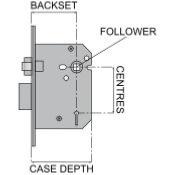 On mortice locks, the "centres" measurement is the distance from the centre of the handle follower to the centre of the keyway or thumbturn etc. For lever handles on backplates with a keyhole, cylinder cut-out or privacy function this measurement is critical and you should ensure that the lock's dimension is compatible with those of your handle backplate or vice versa. Obviously, you should also check that the lock function is compatible with the handle function - you'd be surprised how many people don't.
The "centres" measurement is also important when selecting locks for use with lever handle furniture on rose and with separate keyhole escutcheons or bathroom thumbturns. On UK 3 or 5 lever locks, for example, with a standard centres measurement of 57mm, round roses and escutcheons with a normal diameter of 50mm will be very close on the door when fitted and can end up looking like a figure 8. In addition, the fixing method of many contemporary square design roses requires the rose and escutcheon to have greater distance between them. In many cases these problems can be overcome by fitting a suitable mortice latch plus a relevant deadlock or bathroom deadbolt with the same backset measurement. Alternatively, a European style lock with 72mm/78mm centres can be used.  3 Lever Mortice Sashlock - 57mm Centres 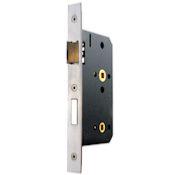 Euro Style Bathroom Lock - 78mm Centres In all cases it is necessary to check the lock or latch for compatibility with the door furniture's method of fixing. For example, rose or backplate fixing screws may foul the lock/latch body if not adequately spaced on thinner doors. If handle roses are supplied with bolt through fixings, locks and latches should be of a type that are pierced to accept them. REBATED DOUBLE DOORS:The vast majority of double doors manufactured in the UK have a rebated overlap on the meeting edges to allow the master door (active leaf) to close on to the slave door (inactive leaf). Where this is the case, mortice locks and latches will normally require a "Rebate Conversion Set" to enable them to be fitted and to function correctly. By far the most common dimension for the depth of rebate is 13mm (see image below) and most manufacturers offer rebate sets for their locks to suit this size. Less common dimensions are 19mm and 25mm and only specialist manufacturers will have suitable rebate sets at these sizes. 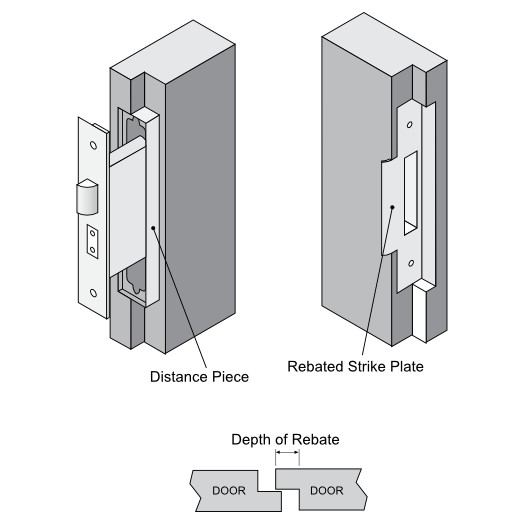 Rebated Double Doors DUTY & FREQUENCY OF USE:Doors in public buildings are obviously subject to a much higher degree of through traffic and general abuse than those in domestic properties. Doors in constant use, heavy doors and/or doors fitted with door closing devices will exert additional force on lock and latch mechanisms. Locks and latches should therefore be selected with with due consideration to duty of use for optimum performance and longevity of service. LOCKS & LATCHES FOR FIRE DOORS & ESCAPE ROUTE DOORS:Items performing a role essential to the operation of fire-resisting doors, smoke control doors and escape route doors should be selected for their ability to cope with the type of use that the door will be put. If a lock or latch fails on a fire door for example, this will, of course, defeat the main purpose of the door and the safety of people and property is put at risk.
England, Wales, Scotland and Northern Island all have regulations and associated technical documents that set out the requirements for the design and construction of buildings so as to secure reasonable standards of health and safety for persons in and around the building. These regulations contain the details relating to fire safety, including provisions relating to fire-resisting doors and escape routes. In addition it is now a criminal offence to supply any construction product that would not enable a properly constructed building in which they were incorporated to satisfy the essential health and safety requirements. By far the best way to ensure compliance is to select products that are marked in accordance with the standard applicable to the product type and that have third party certification for fire door use. All of the locks and latches in our range described as being suitable for use on fire resisting doors have been tested to, and are fully compliant with, current standards and are easily identifiable with the product details clearly showing relevant information. IMPORTANT: Locks and latches for use on fire-resisting door sets should normally be fitted complete with appropriate intumescent material to ensure full compliance. FURTHER HELP & ADVICE:Because of the wide variety of circumstances that exist it is impossible to be prescriptive and this guide is for reference only. Should you require any additional information or would like assistance in selecting any of our ironmongery products please do not hesitate to contact us.
|






